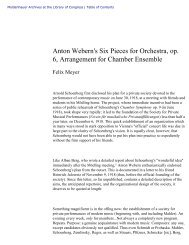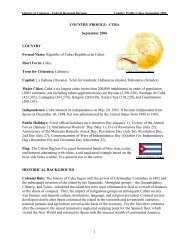1 - American Memory
1 - American Memory
1 - American Memory
You also want an ePaper? Increase the reach of your titles
YUMPU automatically turns print PDFs into web optimized ePapers that Google loves.
176<br />
Ciompletlon of two large Honolulu ofSce buildings was held up, for instance, and<br />
the resultant loss of rentals was serious. A hospital was forced to postpone its<br />
opening date because the dock strike delayed arrival of certain construction<br />
materials necessary for the building's completion. With conditions so uncertain,<br />
developers became hesitant to put new projects out for bid. One large construc-<br />
tion company reported $18 million in lost revenue and $1.5 million in lost profits.<br />
Its employees lost $10 million In wages. A construction materials supplier re-<br />
ported profits before taxes down 225 percent from normal, a substantial loss.<br />
Profits were down 20 percent for an equipment dealer, 20 percent for a general<br />
contracting firm, and 28 percent for one concrete accessories firm.<br />
Hawaii's vital sugar and pineapple export Industries suffer great financial<br />
losses during prolonged shipping strlko^- because they cannot get their products<br />
to market. Even in normal times, the returns on sugar and pineapple are below<br />
acceptable rates. Failure to supply their very competitive markets—as in the<br />
1971-72 dock strike—results in lost customers, further deteriorating the Indna-<br />
tries' financial health.<br />
Our pineapple industry markets 80 percent of Its annual pack through West<br />
Coast ports, and the remaining 20 iiercent by way of Atlantic and Gulf ports. The<br />
1971 West Coast dock strike caught the industry during the peak canning season,<br />
and millions of cases of pineapple backed up here, unable to find their way to<br />
market. One company had more than 9 million cases stored In warhouses at one<br />
time. A load was sent by chartered sMp to the East Coast and hauled back over-<br />
land to CaUfomia to preserve that Important market. Such storage, extra han-<br />
dling, and detoured transportation cost one company a million dollars.<br />
National policy allows foreign pineapple to come into this country duty-free,<br />
but U.S. pineapple Is kept out of foreign markets by high tariffs. The only place<br />
that Hawaii's high-cost pineapple industry can compete is on the Mainland. But<br />
when shipments are temporarily cut off by a transportation Interruption, con-<br />
sumers buy other canned fruits or foreign pineapple, and those customers may<br />
be lost to us forever. It is no wonder that pineapple is a dying Industry in<br />
Hawaii.<br />
The sugar industry also had serious problems during the 1971 dock strike.<br />
Loss of markets has been of deep concern to the Industry because it sells most<br />
of its sugar in the Western states where sugar production Is In surplus. If the<br />
supply of sugar from Hawaii is cut off. industrial users can easily get their<br />
requirements from others, and this lost business is not easily won back. Then<br />
Hawaii is forced to ship Its produce further east, and added transportation cost<br />
reduces margins. A transportation interruption truly reduces sugar's com-<br />
petitiveness.<br />
During the 1971 strike, emergency sugar storage proved Insufflclent, and some<br />
of the production had to be stored outdoors under tarpaulin. More than 91,000<br />
tons of raw sugar and 10,000 tons of molasses were in supplemental storage at the<br />
peak of the strike. Storage was eased to some extent by chartering ships to Gulf<br />
and East Coast ports and to Vancouver, from where the sugar was railed to the<br />
California refinery—but the added expense was enormous. The industry reported<br />
that extra costs resulting from the strike totaled close to $6 million.<br />
Next to suffer from the effects of transportation stoppages are Hawaii's wage<br />
earners, who.se jobs disappear as the economy winds down. The impact on jobs<br />
is not Immediate. Supplies on hand at the beginning of a strike can keep busi-<br />
nesses operating normally for a while, and even when supplies begin to run out,<br />
employers try to keep workers on the payroll by shortening hours or by schedul-<br />
ing vacations during the slack period. But when the stoppage lasts more than<br />
two or three months, the number of people thrown out of work accelerates. What-<br />
ever gains are won by the strikers when the strike ends, the wages lost by these<br />
nonparticipants can never be recovered.<br />
The worst spell of unemployment In Hawaii's modern history followed the<br />
longest dock strike in Hawaii's history. The Islands' unemployment rate was<br />
already up to 7 percent in 1949 as a result of the ongoing national recession.<br />
But the 177-day shutdown of local docks in May-October 1949 sent unemploy-<br />
ment skyrocketing to over 32,000 workers—nearly 17 percent of the labor force<br />
at that time.<br />
The second worst spell of unemployment In Hawaii's modem history followed<br />
the .second longest dock strike. More than 23,000 workers were on the jobless<br />
rolls in November 1971, following the first 100 days of the West Coast dock<br />
strike. When the strike was resumed in January-February 1972, unemployment<br />
rose to 23,650 workers in February. This gave Hawaii an unemployment rate of



![Albert Einstein Papers [finding aid]. Library of Congress. [PDF ...](https://img.yumpu.com/21604228/1/190x245/albert-einstein-papers-finding-aid-library-of-congress-pdf-.jpg?quality=85)





![American Colony in Jerusalem Collection [finding aid]. Library of ...](https://img.yumpu.com/17941275/1/190x245/american-colony-in-jerusalem-collection-finding-aid-library-of-.jpg?quality=85)



![Piccard Family Papers [finding aid]. - American Memory - Library of ...](https://img.yumpu.com/17941234/1/190x245/piccard-family-papers-finding-aid-american-memory-library-of-.jpg?quality=85)


